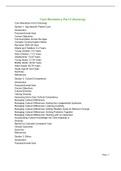Exam (elaborations)
Core Mandatory Part II (Nursing)
- Course
- Institution
Core Mandatory Part II (Nursing) Core Mandatory Part II (Nursing) Section 1: Age-Specific Patient Care Introduction Purpose/Overall Goal Course Objectives Communication Across the Ages Complex Communication Needs Neonates: Birth-28 Days Infants and Toddlers: 0-3 Years ...
[Show more]



